0 Volumes
No volumes are associated with this topic
Natural Science
foo
Thomas Say
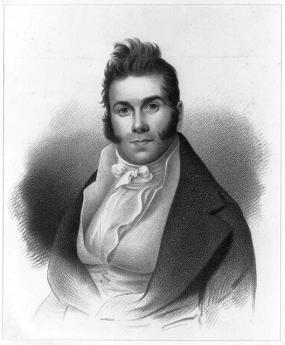
|
| Thomas Say |
When writing to a good friend and fellow naturalist about his exploits in American Conchology, the Philadelphia Entomologist Thomas Say assured his friend that "INSECTS are the great objects of my attention. I hope to be able to renounce everything else and attend to them only." And so he did, writing one of the most important books on the study of North American insects. Say's American Entomology transformed the study of American Natural History from the pastime of science-oriented gentlemen, into a legitimate scientific field.
Thomas Say was born on June 27th, 1787 into a respectable Quaker family, the same summer when men from the newly independent states were meeting for the Constitutional Convention. His father, Benjamin Say, a "fighting Quaker" during the revolutionary war, was a well-established pharmacist and apothecary. His mother was a descendant of the famous naturalist, John Bartram of Bartram Gardens in Kingessing. Say seems to have inherited the naturalist gene, and collected butterflies for his great uncle, William Bartram, as a young boy. Into adulthood, he remained uninterested in all subjects save Natural History.
Say's father, skeptical about his son's obsessive interest in bugs, attempted to set him up in the pharmacy business as a partner with a family friend and fellow naturalist, John Speakman. Unfortunately, both men were more interested in Natural History than business; their partnership failed miserably, leaving Say completely broke but with plenty of time to devote to his passion, Natural History.
This passion contributed to the founding of the Academy of Natural Sciences. Meeting in the houses of local naturalists, and even in Say and Speakman's chemist shop, a small group of young men set out to create an institution where they could collect, share and legitimate the study of Natural History. With Say present at the founding meetings, the Academy of Natural Sciences was established to stop the exportation of scientific research to Europe and establish an American scientific community. Patriotic fervor was particularly notable during the year of the Academy's founding, 1812.
The Academy's progress took a brief hiatus that summer to put a stop to what the new Americans viewed as threats to the young country's independence. Say joined the army and survived its bullets. By the end of the war, and with American economic independence intact, the Naturalists now continued their mission of establishing American intellectual independence. Elected the Conservator of the Academy, Say devoted his life to the maintenance and study of its collections. He is said to have lived in the rooms of the Academy on bread and milk (with an occasional chop or egg) and to have slept under the skeleton of a horse. Notoriously frugal, spending only 6 cents on food every day, Say bemoaned the hassle and expense of dining. He would rather be studying the wings of mosquitoes than wasting time with fancy dining.
During these early days of the United States, Thomas Say was quickly cast as a key member of America's varied and extensive expeditions to discover its largely unknown country. His first was a trip with fellow Academy members to Florida in 1817, a journey cut short by the threat of unfriendly local indigenous tribes. The group did manage to capture a few important species; Thomas Say wrote to a friend that Florida while "not flowing with milk and honey," was "abounding in insects which are unknown."
In 1819, Say was appointed head zoologist for the expedition of Major Long to the Rocky Mountains, where Say discovered and named not only insects, but animals as well, including the Columba fasciata Say, or fan-tailed pigeon. Several years later, in 1823, Say accompanied Long once again, this time on an expedition to the head of the St. Peter's River.
Back in Philadelphia, Thomas Say worked tirelessly to deepen the Academy's intellectual work, publishing many articles for the Academy's Journal on both entomology and conchology. He was also involved with the American Philosophical Society and became professor of Natural Sciences at the University of Pennsylvania. During this busy time, Say also managed to socialize among Philadelphia's upper crust, and is noted as having attended Caspar Wistar's weekly "soirees."
.jpg)
|
| Papilio Glacus from American Entymology |
His urban life did not last, however; Say found himself swept westward in a great tide of social idealism. Robert Owen, a Scottish social reformer, moved to the United States in hopes of establishing a community based on the principles of cooperation, brotherly love, and universal education through the absence of competition, and religious motives. Having purchased the property of the German "Harmonists" in Indiana, Owen persuaded nearly 1,000 people of varying background to help establish a Utopian society. Although Say had a strong democratic spirit, he was perhaps most interested in the move West for what it might offer him in the way of scientific discovery.
In 1826, with both MacClure and Owen, Thomas Say sailed down the Ohio River on what was called the "Boatload of Knowledge," a small ship carrying East Coast intellectuals to their Indiana paradise. Say was put in charge of the operation and named captain of the ship, perhaps due to his experience in the army more than a decade before. It was also on this boat ride to Indiana that Say met his future wife, Lucy Way Sistare, a prospective schoolteacher at New Harmony.
Despite this drastic move, Say remained much more concerned with his study of Natural History than any particular ideological movement, a fortunate enough attitude given the community's short life; after only two years the New Harmony project evaporated because of lack of organization and internal feuds between Owen and his various followers. Say was nevertheless able to use the move out West to his advantage and took part on an expedition to Mexico with William MacClure.
Although voices from the East Coast, and particularly the Academy, called him back, Say stayed in Indiana, publishing his two most famous works, American Entomology and American Conchology. He used illustrations composed over the years by young Titian Peale, son of Say's portraitist, Charles Wilson Peale, as well as Charles Alexandre Lesueur. Lucy Say, his wife, also helped to color the plates for their publication. These two works, and particularly American Entomology were praised abroad as real works of science and as proof the United States had "serious" scientists.
Say experienced relative peace and quiet during his final years in Indiana, a quiet spent in vigorous study of Natural History. However, after years of ill-health, of putting off food for study and his own well-being for that of others, Say died at the young age of 49 in 1834. He was buried at New Harmony, the grave marked with an epitaph capturing his unique passion for the Natural World:
Botany of nature, even from a child,
He saw her presence in the trackless wild;
To him the shell, the insect and the flower,
Were bright and cherished embers of her power.
In her, he saw a spirit life divine,
And worshiped like a Pilgrim at the shrine.
Elias Durand
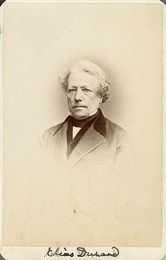
|
| Elias Durand |
Philadelphia has a long and bumpy history with the French, more or less paralleling the British wars with them. But when the guillotine threatened aristocratic necks, Philadelphia offered a sanctuary of new world enthusiasm and sophistication. A few years after the terror, during the reign of Napoleon Bonaparte, Americans scorned his monomaniacal approach to government, returning to the British disdainful view of Frenchmen. In another era, Philadelphia would change its view, displaying a prominent collection of sculptures by the famous French artist, Rodin. And in today's political climate, of course, the French and their socialist leanings are akin to the devil incarnate. It can not be denied, however, the French had a major influence on Philadelphia society and culture. Elias Durand, a former member of the Academy of Natural Sciences whose portrait hangs in the Library Reading room, was a French refugee whose love of Botany greatly expanded American understanding and knowledge of plant life in North America. Somehow, that seems appropriate for an educated Frenchman. But his achievements in commerce were at least as important to his adopted city as his intellectual ones.
The youngest of fourteen children, Durand was born in Mayenne, France in 1794. A passionate chemistry student, he studied pharmaceuticals in school where he was also introduced to the subjects of natural history, mineralogy, geology, and entomology. His rich education in both Mayenne and Paris expanded his interest in chemistry to include the interplay between the hard sciences and the natural world. In 1812, after studying in Paris, Durand joined Napoleon's army, where he served as a medic and "Pharmacien," overseeing the opening of hospitals and the care of wounded soldiers. Even while serving in one of France's most historic wars, Durand remained passionate about the world of plants, by some accounts even collecting plants during the notoriously bloody Battle of Leipzig.
When Napoleon's luck turned bad, Durand focused his attention back to chemistry. In 1814 he left the army and moved to Nantes, where he worked briefly as an apothecary, as well as a lecturer on Medicinal plants in the regional Academy. Durand would remain a teacher throughout his life, instilling those around him with a fascination and passion for the Natural Sciences.
Always a patriotic Frenchman, however, Durand rejoined Napoleon's forces during the general's final hurrah, the "100 days." After Napoleon sustained his ultimate defeat at the battle of Waterloo, Durand retired from military duties and focused once again on the study of pharmaceuticals. His earlier connections to Napoleon, however, led to some uncomfortable clampdowns on the young man's freedom; Durand left the country in disgust in 1816 at being forced to report himself to the police every morning. He sailed to New York in pursuit of a life free from politics and dedicated to his passions of botany and chemistry.
Durand was quickly welcomed into the homes of other French ex-patriots living in Boston and soon met ambitious and science-oriented men who encouraged the young chemist to stay in the country. Hearing there might be work with Dr. Gerard Troost, the first president of the Academy of Natural Sciences, Durand traveled by foot to the mid-Atlantic region. This adventure brought him into contact with local Native Americans, whom he found friendly, as well as local native colonists, whom he found less so.
After a long and arduous journey down the East Coast, Durand finally arrived in Baltimore, only to learn that Troost was not in need of an employee. He was, however, desperate for a companion, and after spending several weeks in Troost's company, Durand left to find work in Baltimore with increased enthusiasm for Botany and in particular native species of North America.
In Baltimore, Durand found work with Mr. Ducatel as a pharmacist and apothecary. He quickly settled into the business, gaining experience in the field and eventually marrying Mr. Ducatel's daughter. But after five years in Baltimore, with both his wife and his father-in-law had passed away, Durand left Baltimore to search for new opportunities.
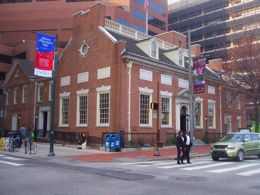
|
| Former Pharmacy at 6th and Chestnut |
He found them in Philadelphia. Perhaps because of the city's burgeoning field of Natural History or its emerging reputation as a medical town, Durand became committed to forging a career in Philadelphia. With the hope of opening a pharmacy in the finely decorated "European Style," Durand returned to France in 1825 to collect materials for this undertaking. Upon his arrival back to town, he set up a shop at 6th and Chestnut streets. His store quickly became world renown for its unique and finely produced medicinal pharmaceuticals, unique in its access to both old world and new world innovations.
Philadelphia proved to be a good move for the young Frenchman; in the next few years he married Marie Antoinette Berauld, a refugee from the St. Domingo Insurrection, and achieved election to the Philadelphia College of Pharmacy.
After his wife died in 1851, Durand gave up business to pursue the study of Botany. He was elected to the Academy of Natural Sciences in 1852, and during his membership published numerous articles and books on the botanical findings of expeditions to the American West and the Arctic. Durand also contributed to the study of Botany through the publication of several biographies about the lives of botanists Thomas Nuttall and Andre Michaux, the famous arborist. Durand's deep and lifelong appreciation for the study of Botany helped bolster the Academy's resources during his membership.
As Durand grew older, his French roots called him back to the homeland; in 1860 he returned to France, and finding the collection of North American specimens lacking in the Jardin des Plantes de Paris, determined to expand the collection himself. He returned to Philadelphia and spent the remainder of his life developing his collection of North American specimens with the help of his son. Eight years later, in 1968, Durand shipped his collection of 10, 000 specie herbarium to Paris where it was arranged in a special gallery named after him, the Herbia Durand. Much of Durand's remaining collection, however, was left to the Academy after his death.
After this long, varied and successful career in the world of Natural Science, Elias Durand died in his home on 9th and Broad Streets (sic) in 1873 at the age of 80. He had contributed greatly to the fields of Botany and helped to establish Philadelphia's respected reputation in the world of medicine. Although a Frenchman at heart, Durand remains a feather in Philadelphia's cap and an important face at the Academy of Natural Sciences.
Ball Lightning, Regular Lightning, and B. Franklin
Just about everybody knows that flying a kite in a lightning storm is too dangerous to consider, but hardly anyone appreciates the enormous scientific significance of what happened at 10th and Chestnut Street in 1752. Benjamin Franklin discovered electricity, essentially explained it, displayed its commercial value with lightning rods (but never patented or profited from them), and received the acclaim of the scientific community which would have won him a Nobel Prize if such a thing had existed then. It's true this didn't happen overnight; in many ways, he made the clinching demonstration on the shores of France. Something called the torpedo fish lives there, and Franklin gathered a group of friends holding hands in a circle, demonstrating the electric shock started with the fish and traveled around the circle. Out of this appreciative circle of scientists emerged his rightful reputation as a scientist of the first rank, soon to be the most famous American in the world.
But while millions of people had observed lightning flashes before Franklin connected one to a Leyden jar, those millions were merely content to go inside the house before it started to rain. Millions more still think of the whole episode as a quaintly stupid thing to do, without much scientific or practical value. Dangerous it was indeed, and it knocked young Franklin for a loop at another time and killed several other people who tried to repeat it. But to grasp the scientific feel of it, let's put yourself in Ben's shoes. Let's look at a probably related issue, called ball lightning.
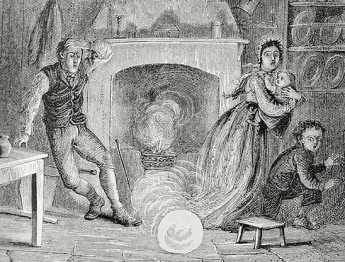
|
| Ball of Lightning |
Ball lightning is relatively uncommon, but some chronicler has calculated that about a half of one percent of the world's population has observed it. Counting from the beginning of history, that means a lot of ball lightning. Let's describe it here in the words of two Philadelphians who have actually seen it. One lady describes that she was in her kitchen on the Main Line during a thunderstorm when a big ball of light about the size of a basketball bounced through the door and sat on her stove for at least a full minute. It didn't give off much heat, didn't explode, and didn't smell bad. Although she was badly shaken emotionally, she doesn't remember anything much more. It just went away.
And another Philadelphian was on an airplane in a thunderstorm, back in the days when planes mostly flew below the clouds. A smaller blob of ball lightning appeared from nowhere and rolled down the aisle. Although no one kicked it or did anything else stupid, it created its sensation and then was gone.
A student of this matter says that although ball lightning is comparatively rare, it does occur often enough for extensive credible descriptions to exist. The size is most commonly between that of a pea and a sofa. It is not reported to give off much heat, usually but not invariably appears during a thunderstorm. Ball lightning appears to favor appearances over the ocean, and surfaced submarines seem over-represented among reporters of it. By report, the ball usually disappears with an explosion which does not sound like thunder but leaves behind a sulfurous odor. People who physically tangled with it, have been killed.
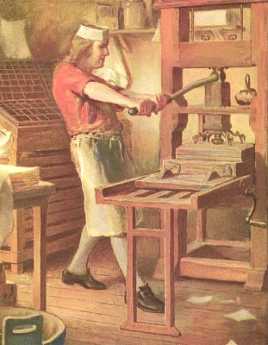
|
| Young Franklin and Print Press |
From the descriptions of crowds of people surrounding some of them, it seems unlikely these phenomena are merely visual hallucinations induced by lightning strikes, as has been suggested by some. And just what it would feel like to be that close to astronomical black holes, has not been reported by any survivors. Black holes are found scattered all over the universe, so there is no reason small ones couldn't appear on the Main Line, but it would seem likely they would be surrounded by a turbulent force field of some kind. Lots of other theories have been propounded, but haven't developed much scientific traction. In short, the state of ignorance about ball lightning today is about as total as about regular lightning bolts in the Eighteenth century.
So, there you are, a mysterious natural phenomenon which everybody ignores, just waiting for some amateur to get curious enough to devise a simple experiment to explain it. The remarkable thing about the discovery of electricity was not that it was a problem crying out for a solution, or a dangerous dragon needing to be slain. It was just something that everybody noticed, and everyone ignored. What was remarkable about this episode was not the nature of the phenomenon, but the unusual nature of the curiosity of a local printer named Ben.
Tyler Arboretum
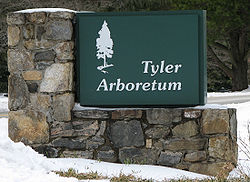
|
| Tyler Arboretum |
There are over thirty arboreta in the Philadelphia region, and one of the oldest and largest is located in Delaware County. The 650 acres of the Tyler Arboretum, adjoining 2500 acres of a state park, create a rather amazing wooded area quite close to heavily settled urban Philadelphia. The Arboretum is located on land directly deeded by William Penn, but it was privately held until 1940 and so is not as well known as several other arboreta of the region. The early Quakers, it may be recalled, often disapproved of music and "artwork", so their diversions tended to concentrate on various forms of natural science. The first director of the Tyler, Dr. John Wister, planted over 1500 azalea bushes as soon as he took office in the 1940s. They are now seventy or eighty years old, quite old and big enough to make an impressive display. Even flowering bushes seemed a little fancy to the original Quakers.
The interests of the earlier owners of the property were more focused on trees, especially conifers. The property contains several varieties of redwoods, including one impressive California redwood, said to be the largest east of the Mississippi. High above the ground, it splits into two main branches, the result of depredation by someone cutting the top off for a Christmas tree. So a large area near Painter Road is enclosed by a high iron fence, containing most of the conifer collection, and warding off the local white-tailed deer. Several colors of paint are to be seen high on many prominent trees, marking out several walking trails of varying levels of difficulty.
And then there are large plantings of milkweed, providing food for migrating butterflies; near a butterfly educational center. There are large wildflower patches and considerable recent flower plantings around the houses at the entrance. Because of the, well, Christmas tree problem, several houses on the property are still occupied.
The only serpentine barren in Delaware County is located on the property; we have described what that is all about in another essay. As you would imagine, there are great plant and flower auctions in the spring, conventions of butterfly and bird-watching groups at other times. The educational center is attracting large numbers of students of horticulture these days, and photographers. Flower gardens and photographers go together like Ike and Mike.
It's a great place for visitors, for members who are more involved, and for those with serious interests. With all that land to cover, some ardent walkers have enough ground to keep them regularly busy. Becoming a volunteer is a sign of serious interest, and that group is steadily growing. For a place that traces back to William Penn, it's slowly getting to be well known.
Not a Single Red Knot
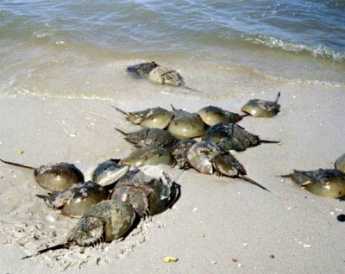
|
| Horseshoe Crabs |
A full moon brings high tide, which for centuries has brought vast numbers of horseshoe crabs to the banks of the Delaware River, toward the end of May. Marine biologists tell us these ugly-looking beasts have evolved very little for thousands of years.
Horseshoe crabs transport oxygen through their blood as a blue copper compound instead of that iron-containing hemoglobin the rest of us use. That's red, of course. Somewhere in the evolutionary path, these ancient animals also neglected to develop an immune system, but defend themselves against bacteria by precipitating sediment when they encounter endotoxin. By luck, this reaction takes place even though the bacteria are dead, so it is routinely employed as a way of detecting and eliminating endotoxin in intravenous fluids, which would otherwise go undetected by failing to grow the original bacteria in conventional culture media. Unfortunately, those of us who have never experienced a temperature spike to 106 degrees from an intravenous infusion of "sterile" water is more or less indifferent to the contribution of the Delaware crabs to our well-being. As well as being sadly indifferent to the unique nature of their nerve cells, in long single neurons, which make a number of important experiments possible.
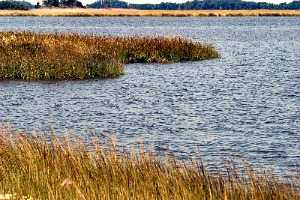
|
| Bombay Hook |
The horseshoe crab offers still other attractions. When they come ashore to lay eggs (at a full moon, or high tide, in May), they lay incredibly large quantities of them, attracting astonishing swarms of birds, which can be seen gliding a few feet above the water surface in groups of hundreds or even thousands. The Red Knot sandpiper is certainly not the only egg-eater at Bombay Hook, but there are some unique features of that bird to be mentioned in a minute. A lot of people object to being attacked by monster swarms of mosquitoes in the summer, but screens and air-conditioning have encouraged a large number of rather prosperous houses to be built along the shore, particularly where there are sandy beaches. In fact, it is so crowded the Fish and Wild Life Service has placed street lights at such public places, with a narrow driveway to lead you to the beach. If you don't know how to recognize such amenities, well, too bad for outsiders.
Although there are plenty of naturalists and bird-watchers who come in the early spring, most of the houses along "Slaughter Beach" seem to belong to fishermen and duck hunters, the two outdoor sports with most popularity. Different migrations of different food-producers bring different prey for the sportsmen, but somehow the most up-scale members of this fraternity tend to go there in May, looking for Red Knots. A Red Knot is a form of sandpiper, with a red head and breast. The birds are born in the Arctic tundra, eating vast amounts of mosquito eggs and larvae, migrating south in the fall. They winter over in Tierra del Fuego at the opposite end of the earth and then migrate north to Bombay Hook on Delaware. For these long migrations, they must eat voraciously when they do eat and somehow have learned to look for the horseshoe crab eggs at just the right time, presumably following cycles of the moon for timing. Residents of the area for centuries have remarked on the timing of the birds and the tides and the crabs. Unfortunately, the two-continent migration was only recognized fairly recently, and when the supply seemed endless, the crabs were scooped up and used for fertilizer until their supply began to dwindle; both Delaware and New Jersey now have protective legislation, and Virginia is being verbally excoriated by bird watchers, to do the same. The crabs have started to come back, but the Red Knots are slower to respond, and now the threat is Sushi. Another ecological damage has reduced the supply of crabs in the Pacific, so the crab fishermen have migrated to the Atlantic to catch the crabs as bait for conch and other ingredients of Sushi. Once again, the abundance of crabs has declined, although to a much smaller degree than the Red Knots. This year, on the very best day of the year for this sort of thing, with dozens of out-of-state license plates wandering aimlessly up and down thirty miles of shoreline, the shouted greetings among serious bird watchers returned the sad news, "No Red Knots today. Try the beach." It was generally agreed there was a bit too much wind for good Red Knot sighting, and that oil spills in the Gulf of Mexico were to be suspected, and that perhaps tomorrow would be a better day. But judging by the very expensive optical equipment these people were carrying around, these were serious birders, indeed. If they couldn't find Red Knots, the rest of us might as well give up.
The most plausible theory for the latest decline centers around the old-timer birds. When the first-timers start their northward migrations, they are guided by the old-timers who have made the trip at least once before. If something injures the flock, it may be a few years before the supply of old-timers revives enough to supply the first-timers with guides. That's just a theory, of course, but currently the most popular one. Just what it would take to eliminate the Red Knot migration completely, may now be close to being tested. Just on principle alone, it does seem a pity to eliminate a phenomenon which took thousands of years to develop.
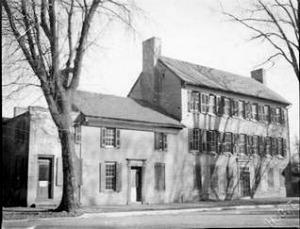
|
| Benjamin Chew's Whitehall |
When you finally give up on Red Knots, you might as well wander around this enormous wildlife sanctuary. A few miles up the road is the former location of Whitehall, the plantation house of Benjamin Chew, lawyer for the family of William Penn, and owner of the stone fortress on Germantown Avenue in Philadelphia that thwarted George Washington's attempt to stall and starve the British before they could join up with their ships in the harbor below Fort Mifflin. The original buildings on the plantation have disappeared, but the spongy plantation trails have been replaced by elevated gravel roads. So it is possible to roll up the windows of your car in mosquito season, turn on the air conditioning, and cruise around the spectacularly beautiful ponds and inlets. Further south is the plantation of Caesar Rodney, who rode to Philadelphia in the rain to cast the deciding vote for the Declaration of Independence. And further south of that is the plantation of John Dickinson, who made Rodney's ride necessary by refusing to sign the Declaration, on the grounds that the colonies showed insufficient unity, in his eyes, to be able to win a war with England. And anyway, the argument was largely economic, hence more likely to be won by economic means than military ones.
To the west of these historic plantations are some pretty impressive farms, new style. The houses give them away since no farmer will spend a cent on his house if he can profitably expand his farm; these houses belong in glossy magazines. The silos are grouped in clusters of ten or twelve, the irrigation sprinklers are a quarter-mile long, attachable to what resembles a fire hydrant in the center of the field. There are over a hundred sheds on some farms, filled with chickens fattening up. And do you know what? You can drive for miles without seeing a single chicken.
Eventually, the road leads to the Dover Air Force Base, very large indeed. No planes are in evidence, as is true on most days. But one day in 1962 Mr. Kennedy was talking to Mr. Castro, and overhead at Dover you could see dozens, maybe hundreds, of eight-engine bombers. Just circling, circling, waiting for orders to go lay an egg on the Kremlin. It wasn't clear to onlookers at the time, just what this was all about. But the idea can now be entertained that perhaps Red Knots weren't the only species flirting with extinction.
Ginseng Trading
DECLARATION of a state of war between Great Britain and its colonies almost immediately set loose some thinking about how to divert some of the profits and commercial arrangements of the British Empire to other owners. In particular, the American merchants began to consider how to capture colonial trade with China, or at least look into what useful gossip they could pick up in the many dealings with sea captains in port, or traders in their counting houses. The waterfront has always been a tough place, and in the seaside taverns, it can be particularly difficult to get trustworthy information or form dependable commercial alliances. So it is not entirely surprising if the captains and agents of Robert Morris found themselves in the company of many seafarers who later proved to be little short of pirates. England was conducting a lucrative trade with China, and the American colonies supplied much of the commodities. The Treaty of Paris suddenly transformed smuggling and near-piracy into open season for international trade, with much room for sharp practice.
On February 22, 1784, the Empress of China, a brand-new copper bottomed vessel built in Boston for a dubious trader named Daniel Parker, set sail from Manhattan for Canton. John Cleve Green was the captain, and ownership was a confused tangle of William Duer, John Holker, and a firm of Turnbull, Marmie, and Company which was essentially a disguised agency of Robert Morris, with Morris the dominant owner. The ship had a cargo of two commodities: 250 casks of ginseng, and twenty thousand dollars in silver. The ship would return from China a year later, bearing tea, silks, and porcelain. The world was in a post-war depression, and the numerous part owners of the venture were barely speaking to each other. But five years later it was recorded that 19 American vessels were tied up in the port of Canton. Just whose idea it was, and who gets the main credit for making it a success can be endlessly disputed, both inside and outside the courtroom. But this was in broadest outline, how the China trade began.
The rest of the story is mainly a botanical one.
Weather Man
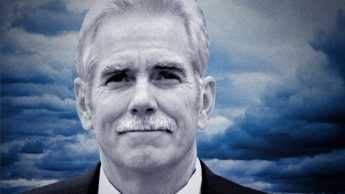
|
| Paul Walsh |
PAUL Walsh, our local weatherman, recently addressed the GIC (Global Interdependence Center) at the Federal Reserve, and presumably because everyone talks about the weather, the meeting was well attended. While he is too experienced to get drawn into a global warming controversy, we get the general outline of his views. What we call the weather is largely a result of various clouds and wind currents blowing around the planet in response to the rotation of the planetary mixture of oceans and land masses. The familiar landscape visible to astronauts makes it easy to accept this view of things.
The global warming issue, however you explain it and where ever it may be going, is a weather cycle to be measured in centuries. Shorter cycles of about eight years in duration tend to result in American weather patterns sometimes blowing Canadian cold air toward the East Coast, and sometimes blowing California winter weather Eastward. In 2011-12 we seem to be experiencing a California winter, while the preceding two winters were unusually cold, reflecting Canadian conditions. What may or may not be happening with the hundred-year global warming cycle is not easily slipped into our daily conversations. It is probably quite irrelevant to global trends whether or not last year was a cold one, or whether our sidewalks are unusually slippery this morning.
Inquiries about the weather are the number one topic to be clicked on the Internet, reaching 17% of queries. That's nearly double the second largest category and four times the number of inquiries about the stock market. Ordinary variations of the weather have been calculated to have an economic value of $384 billion, or 3.4% of the Gross Domestic Product (GDP). Insurance claims for more severe weather abnormalities run between ten and fifty billion dollars a year. The number of hurricanes and similar disasters is highly variable, sometimes running as high as fifty in a bad year.
Predictions are improving, but ridicule of weatherman errors is still highly embarrassing to the professionals in the business. A generation ago, it was almost impossible to get a one-minute warning of an approaching tornado, but nowadays we average fourteen minutes warning for them. That's almost long enough to be useful. Hurricanes seem to be increasing in frequency, but decreasing in average intensity. But insurance claims are getting steadily higher, largely because more people are building more structures in harm's way.
Small wonder that weathermen are a cautious lot about predictions. The present party line, in case you wanted to ask, is that predictions more than ten years in advance -- are just about impossible.
Evo-Devo
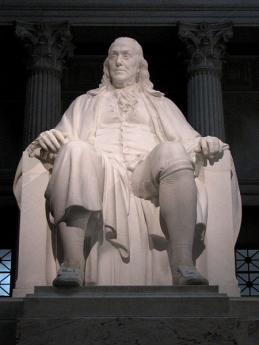
|
| The Franklin Institute of Philadelphia |
THE oldest annual awards for scientific achievement, probably the oldest in the world, are the gold medals awarded by the Franklin Institute of Philadelphia for the past 188 years. Nobel Prizes are more famous because they give more money, but that in a way involves another Philadelphia neighborhood achievement, because Nobel's investment managers have run up their remarkable investment record while operating out of Wilmington, Delaware. In the past century, one unspoken goal of the Franklin Institute has been to select winners who will later win a Nobel Prize, the actual outcome more than a hundred times. That likelihood is one of the attractions of winning the Philadelphia prize, but in recent years some Nobel awards have acquired the reputation of being politicized particularly the Peace and Literature prizes. Insiders at the Franklin are positively fierce about avoiding that, so the Franklin Institute prizes have become known for recognizing talent, not merely fame.
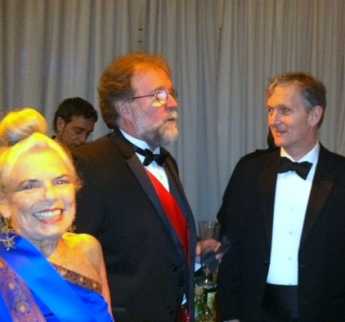
|
| Dr. Jan Gordon, Dr. Sean Caroll, and Dr. Cliff Tabin |
Within Philadelphia, the annual awards ceremony is one of the four top social events. The building will seat 800, but reservations are normally all sold out before invitations are even put in the mail. A major source of this recent success is clear; in the past twenty-five years, the packed audience is a star in the crown of Dr. Janice Taylor Gordon. This year, she hurried back from a bird-watching trip in Cuba, just in time to busy herself in the ceremonies where she sponsored Dr. Sean Carroll of the Howard Hughes Foundation and the University of Wisconsin, for the Benjamin Franklin medal in the life sciences. Carroll's normal activities are split between awarding $80 million a year of Hughes money for improving pre-college education from offices in Bethesda, Maryland, and directing activities of the Department of Genetics in Madison, Wisconsin. His prize this year has relatively little to do with either job; it's for revolutionizing our way of thinking about evolution and its underlying question, of how genes control body development in the animal kingdom. Evolution and Development are academic terms, familiarly shortened to Evo-Devo.
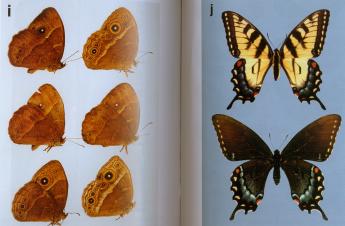
|
| Dr. Carroll's Butterflies |
My former medical school classmate Joshua Lederberg, also a resident of Philadelphia, was responsible for modern genetics, demonstrating linkages between the DNA of a cell, and the production of a particular body protein. For a time it looked as though we might confidently say, one gene, one protein, explains most of the biochemistry. In the exuberance of the scientific community, it even looked as though deciphering the genetic code of 25,000 human genes might explain all inherited diseases, and maybe most diseases had an inherited component if you took note of inherited weaknesses and disease susceptibilities. But that turned out to be pretty over-optimistic. Lederberg got into an unfortunate scientific dispute with French scientists about bacterial mating and now appears to have been wrong about it. But the most severe blow to the one gene, one protein explanation of disease came after the NIH spent a billion dollars on a crash program to map out the entire human genetic code. Unfortunately, only a few rare diseases were explained that way, at most perhaps 2%. Furthermore, all the members of the animal kingdom turned out to have pretty much the same genes. Not just monkeys and apes, but sponges and worms were wildly different in outward appearance, but substantially carried the same genes. Even fossils seem to show this has been the case for fifty million years. Obviously, animal genes have slowly been added and slowly deleted over the ages, but in the main, the DNA (deoxynucleic acid) complex has remained about the same during modest changes in evolution. Quite obviously, understanding the genome required some major additions to the theory's logic.
In late 1996, three scientists met in Philadelphia for a brain-storming session. Sean Carroll had demonstrated that mutations and perhaps an evolution of the wing patterns of butterflies and insects took place during their embryonic development, and seemed to be controlled by the unexplored proteins between active genes. Perhaps, he conjectured, the same was true of the whole animal kingdom. Gathered in the Joseph Leidy laboratory of the University of Pennsylvania, the three scientists from different fields proposed writing a paper about the idea, suggesting how scientists might explore proving it in the difficult circumstances of nine-month human pregnancies, in dinosaurs, in deep-sea fish and many remote corners of the animal kingdom. Filling yellow legal pads with their notes, the paleontologist (fossil expert) Neal Shubin of the University of Pennsylvania, genetic biologist (Sean Carroll of Wisconsin), and Harvard geneticist Cliff Tabin worked out a scientific paper to describe what was known and what had to be learned. The central theme, suggested by Carroll, was that evolution probably takes place in the neighboring regulatory material which controls the stage of life early in the development of the fetus, and these regulatory proteins consist of otherwise inactive residual remnants of ancient animals from which the modern species had evolved. As the fetus unfolds from a fertilized egg into a little baby, its outward form resembles fish, reptiles, etc. And hence we get the little embryonic dance of ancient forms morphing into modern ones. In deference to the skeptics, it would have to be admitted that the physical resemblance to adult forms of the ancient animals is a trifle vague.
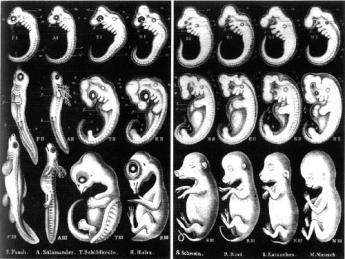
|
| Haeckel's drawings of vertebrate embryos, from 1874 |
Embryologists have long argued about Ernst Haeckel's incantation that "Ontology recapitulates phylogeny", which is a fancified way of saying approximately the same thing. Darwin's conclusion was more measured than Haeckel's and explanations of the phenomenon had been sidelined for almost two centuries. But it seems to be somewhat true that fossils which paleontologists have been discovering, going back to dinosaurs and beyond, do mimic the stages of embryonic development up to that particular level of evolution, and might even use the same genetic mechanism. The genetic mechanism might evolve, leaving a trail behind of how it got to its then-latest stage. Borrowing the "Cis" prefix ("neighboring") from chemistry, these genetic ghosts have become known as Cis-regulatory proteins as the evidence accumulates of their nature and composition. Growing from the original three scientists huddled in Shubin's Leidy Laboratories in 1996, academic laboratories by the many dozens soon branched out, dispatching paleontologists to collect fossils in the Arctic, post-doctoral trainees to collect weird little animals from the deserts of China, and the caves of Mexico, everywhere confirming Carroll's basic idea. Even certain forms of one-celled animals which occasionally form clumps of multi-celled animals have been examined and found to be responding to a protein produced by neighboring bacteria which induces them to clump -- quite possibly the way multi-cellular life began. Many forms of mutant fish were extracted from caves to study how and why they developed hereditary blindness; the patterns of markings on the wings of butterflies were puzzled over, and the markings on obscure hummingbirds. The kids in the laboratory are now having all the fun with foreign travel, while the original trio finds themselves spending a lot of time approving travel vouchers. Many fossils of animals long extinct have been studied for their evolution from one shape to another, especially in their necks, wings, and legs. Some pretty exciting new theories emerged, and are getting pretty well accepted in the scientific world. At times like this, it's lots of fun to be a scientist.
American Chestnut Trees
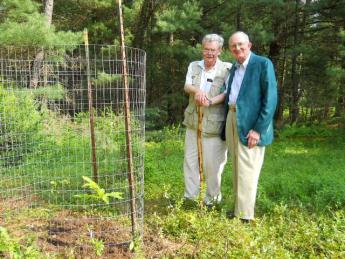
|
| American Chestnut tree |
RECENTLY, John Wenderoth of the Tyler Arboretum visited the Right Angle Club of Philadelphia, bringing an astounding account of the triumph, near-extinction, and revival of the American Chestnut tree. The Tyler Arboretum, and this man, in particular, is at the center of the movement to rescue the tree, although the modern Johnny Appleseeds of the movement seem to be a Central Pennsylvanian named Bob Leffel, and a geneticist named Charles Burnham. Together, they had the vision and drive to enlist a thousand volunteers to plant seedlings in Pennsylvania; and there are many other volunteer groups in other states within Appalachia. About 45,000 Chestnut hybrids have been planted, surrounded by wire fencing to protect the new trees until they grow too tall for deer to reach the leaves. Here's the story.
In 1904 it was estimated that a fourth of all trees in the Eastern United States were American Chestnuts. The tree typically grew to eighty feet before permanent branches took over, so the shading and tall pillars of tree trunks gave the forest a particular cathedral-like distinctiveness, much celebrated by such authors as James Fennimore Cooper. The wood of the American Chestnut tree is rot-resistant, so it was favored by carpenters, log-cabin builders, and furniture makers. It once was a major source of tannin, for leather tanning. The nuts were edible, but it has been a long time since they were available for much eating. The chestnuts you see roasted by sidewalk vendors are primarily Chinese Chestnuts, which actually come to us from South Korea. The Buckeye, or horse chestnut, produces a pretty and abundant nut but is too bitter for most tastes. For whatever reason, a fungus was first discovered to infect the chestnuts of the Bronx Zoo in 1905, attracting the attention of Teddy Roosevelt and his Progressive naturalist friends, but to little avail. The fungus (Cryptomeria parasitic) enters the tree through cracks in the bark, flourishes in the part of the tree which is above ground, leaving the roots undisturbed. Ordinarily, when this sort of thing happens, the roots send up shoots which keep the tree alive and flourishing. Unfortunately, the abundant deer of this area quickly nipped off the shoots as they appeared, and finally, the trees died. It took only a decade or so for this combination of natural enemies to wipe out the species, and today it is unusual to see lumber from this source. The forests of Chestnuts have been replaced by other trees, mostly oaks. The Chinese chestnut, however, proved to be resistant to the fungus, even though it does not grow to the same height.
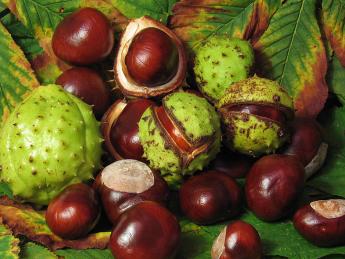
|
| Chinese Chestnuts |
After many futile but well-meaning efforts to save the trees by foresters, friends of the American Chestnut tree turned to geneticists. The goal was to transfer the fungus resistance gene from the Chinese Chestnut to a few surviving American Chestnuts. It took six or seven generations of cross-breeding to do it (four generations of seedlings, then crossing the crosses, then weeding out the undesirable offspring), but eventually, the Tyler Arboretum was supplying truckloads of seedlings to the volunteers to plant in likely places. It's going to take many years for the seedlings to grow in sufficient numbers to make an impact on our forests, and eventually on our carpenters, but that effort is underway with gusto. If anyone wants to volunteer to join this effort, there appears to be room for plenty more people to help.
9 Blogs
Thomas Say
 Thomas Say's portrait hangs in the Ewell Sale Stewart Library at the Academy of Natural Sciences in remembrance of his love of bugs and passion for the Academy.
Thomas Say's portrait hangs in the Ewell Sale Stewart Library at the Academy of Natural Sciences in remembrance of his love of bugs and passion for the Academy.
Elias Durand
 After first fighting in the Napoleonic wars, a French ex-pat brought a European flare both to Pharmacy and the study of Botany in the United States.
After first fighting in the Napoleonic wars, a French ex-pat brought a European flare both to Pharmacy and the study of Botany in the United States.
Ball Lightning, Regular Lightning, and B. Franklin
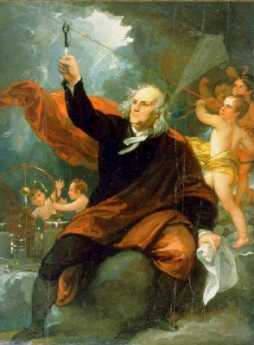 Knowledge about ball lightning is as dismal today as Franklin found the state of knowledge about regular lightning in 1752. Let's put ourselves in his shoes.
Knowledge about ball lightning is as dismal today as Franklin found the state of knowledge about regular lightning in 1752. Let's put ourselves in his shoes.
Tyler Arboretum
 A 650-acre Arboretum next to a 2500-acre state park makes for a lot of nature walks and bird watching, as well as a gazillion azaleas and tree specimens. The only serpentine barren in Delaware County is located there.
A 650-acre Arboretum next to a 2500-acre state park makes for a lot of nature walks and bird watching, as well as a gazillion azaleas and tree specimens. The only serpentine barren in Delaware County is located there.
Not a Single Red Knot
 Between the Dover Air Force Base and the west bank of the Delaware River is a large area of wetland and fertile soil centered on what is called the Bombay Hook. Benjamin Chew, Caesar Rodney, and John Dickinson all had extensive plantations there. In some ways, remarkable wealth is all centered on the fertility deposited over the centuries by the eggs of horseshoe crabs along the bank
s of the river.
Between the Dover Air Force Base and the west bank of the Delaware River is a large area of wetland and fertile soil centered on what is called the Bombay Hook. Benjamin Chew, Caesar Rodney, and John Dickinson all had extensive plantations there. In some ways, remarkable wealth is all centered on the fertility deposited over the centuries by the eggs of horseshoe crabs along the bank
s of the river.
Ginseng Trading
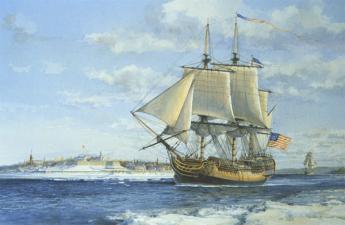 The Chinese love ginseng for its alleged aphrodisiac qualities, so it is not surprising that trade has flourished between China and Philadelphia. What's surprising is that ginseng flourishes in our exurbs, and is mostly exported to China, not from it.
The Chinese love ginseng for its alleged aphrodisiac qualities, so it is not surprising that trade has flourished between China and Philadelphia. What's surprising is that ginseng flourishes in our exurbs, and is mostly exported to China, not from it.
Weather Man
 The weather is a big business.
The weather is a big business.
Evo-Devo
 The Franklin Institute has been making awards for scientific achievement for 188 years, long before the Nobel Prize was invented. The seats are all reserved before the meeting notices are even mailed.
The Franklin Institute has been making awards for scientific achievement for 188 years, long before the Nobel Prize was invented. The seats are all reserved before the meeting notices are even mailed.
American Chestnut Trees
 Scarcely a century ago, American Chestnut trees were a quarter of all trees in America. Now, they are almost all gone, but a thousand volunteers are trying to rescue them.
Scarcely a century ago, American Chestnut trees were a quarter of all trees in America. Now, they are almost all gone, but a thousand volunteers are trying to rescue them.